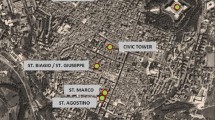Abstract
The growing number of demand for a widespread of health monitoring for strategic buildings in seismic areas has emphasized the need to realize in-depth scientific studies, in order to verify the feasibility of economic and fast methods to detect anomalous vibrations, to execute post earthquake warning and monitoring, damage assessment and first damage scenarios. Generally, an effective system for structural health monitoring requires an appropriate number of sensors, suitably located in the structures, and complex elaborations of big amounts of data. The simplified method presented in this paper is based on a statistical approach that uses the most significant data recorded on the top floor of the building, with the purpose of extracting information on the maximum inter-story drift, used as damage indicator. The parameters considered in the method are (i) maximum top acceleration, (ii) the first modal frequency variations and (iii) the equivalent structural viscous damping variation. A big amount of experimental data relevant to several tests carried out on scaled R/C models and numerical non linear dynamic analyses have been used to verify the feasibility of this approach.
Similar content being viewed by others
References
Ditommaso R, Parolai S, Mucciarelli M, Eggert S, Sobiesiak M, Zschau J (2010) Monitoring the response and the back-radiated energy of a building subjected to ambient vibration and impulsive action: the Falkenhof Tower (Potsdam, Germany). Bull Earthq Eng 8(3). doi:10.1007/s10518-009-9151-4
Doebling SW, Farrar CR, Prime MB (1998) A summary review of vibration-based damage identification methods. Shock Vib Dig 30(2): 91–105
Dolce M, Cardone D, Di Cesare A, Moroni C, Nicoletti M, Ponzo FC, Nigro D (2005) Dynamic tests on a 1:4 scaled R/C existing building: comparison of several isolation systems. 9th Assisi, Kobe
Dolce M, Cardone D, Moroni C, Nigro D, Ponzo FC, Di Cesare A, Ventura G, De Canio G, Ranieri N, Goretti A, Marnetto R (2006) Experimental performance of exist-ing R/C building seismically upgraded with new added viscous damping rubber isolators. 4th world conference on structural control and monitoring. July San Diego, USA
Dolce M, Ponzo FC, Masi A, Mucciarelli M, Gallipoli M, Di Cesare A, Tetta M, Vona M (in press) Identification of the structural model and analysis of the global seismic behaviour of the IACP Bonefro building. The BobCode Project, BEE Special Issue
Gabor D (1946) Theory of communication. IEE J 93: 429–457 London, U.K
Herak M, Herak D (2010) Continuous monitoring of dynamic parameters of the DGFSM building (Zagreb, Croatia). Bull Earthq Eng. doi:10.1007/s10518-009-9112-y
Laurenzano G, Priolo E, Gallipoli MR, Mucciarelli M, Ponzo CF (2010) Effect of vibrating buildings on free-field motion and on adjacent structures: the bonefro (Italy) case history. Bull Seismol Soc Am 100(2): 802–818. doi:10.1785/0120080312
Mucciarelli M, Gallipoli MR (2007) Damping estimate for simple buildings through non-parametric analysis of a sin-gle ambient vibration recording. Ann Geoph 50: 259–266
Ordinanza del Presidente del Consiglio dei Ministri No. 3431/2005. Ulteriori modifiche ed integrazioni all Ordinanza del PCM n. 3274 del 20.03.2003, Roma, 3 Maggio (2005)
Park YJ, Ang AH-S (1985) Mechanistic seismic damage model for reinforced concrete. J Struct Eng 111(4): 722–739
Park YJ, Ang AH-S, Wen YK (1987) Damage-limiting aseismic design of buildings. Earthq Spectra 3(1): 1–26
Piccolo D (1998) Statistica. Società editrice Il Mulino, Bologna
Picozzi M, Milkereit C, Zulfikar C, Fleming K, Ditommaso R, Erdik M, Zschau J, Fischer J, Safak E, Özel O, Apaydin N (2010) Wireless technologies for the monitoring of strategic civil infrastructures: an ambient vibration test on the Fatih Sultan Mehmet Suspension Bridge in Istanbul, Turkey. Bull Earthq Eng 8(3): 671–691
Picozzi M, Ditommaso R, Parolai S, Mucciarelli M, Milkereit C, Sobiesiak M, Di Giacomo D, Gallipoli MR, Pilz M, Vona M, Zschau J (2010b) Real time monitoring of structures in task-force missions: the example of the Mw = 6.3 Central Italy Earthquake, April 6, 2009. Natural Hazards 52(2) / February, 2010. doi:10.1007/s11069-009-9481-1
Rytter A (1993) Vibrational based inspection of civil engineering structures. Ph.D. Thesis, University of Aalborg, Denmark
Stubbs N, Perk S, Sikorsky C, Choi S (2000) A global non-distructive damage assesment methodology for civil engineering structures. Int J Syst Sci 31(11): 1361–1373
Todorovska M, Trifunac M, Hao T-Y (2006) Variations of apparent building frequencies-lessons from full-scale earthquake observations. First European Conference on Earthquake Engineering and Seismology, Geneva Switzerland, pp 3–8
Wilson EL (2002) Three dimensional static and dynamic analysis of structures. CSI Computer and Structures Inc, Berkeley
Author information
Authors and Affiliations
Corresponding author
Rights and permissions
About this article
Cite this article
Ponzo, F.C., Ditommaso, R., Auletta, G. et al. A fast method for structural health monitoring of Italian reinforced concrete strategic buildings. Bull Earthquake Eng 8, 1421–1434 (2010). https://doi.org/10.1007/s10518-010-9194-6
Received:
Accepted:
Published:
Issue Date:
DOI: https://doi.org/10.1007/s10518-010-9194-6




